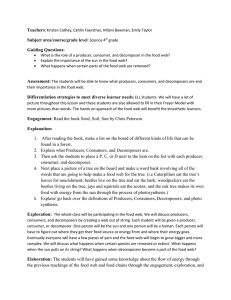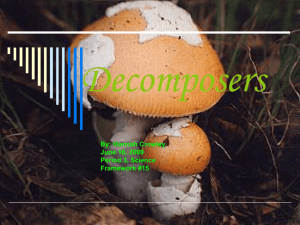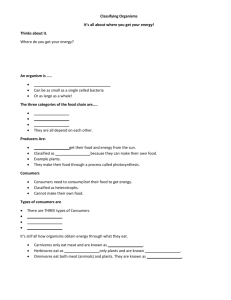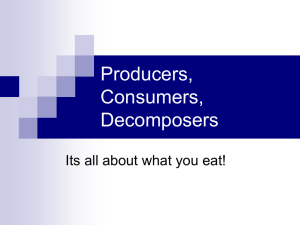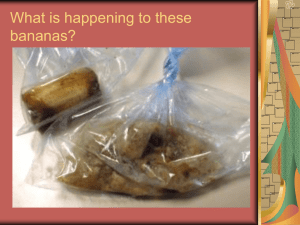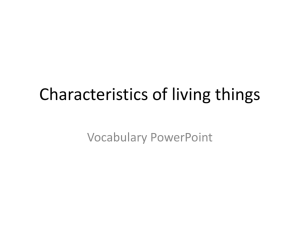Proficient_Plus_Science_Direct_3rd
advertisement
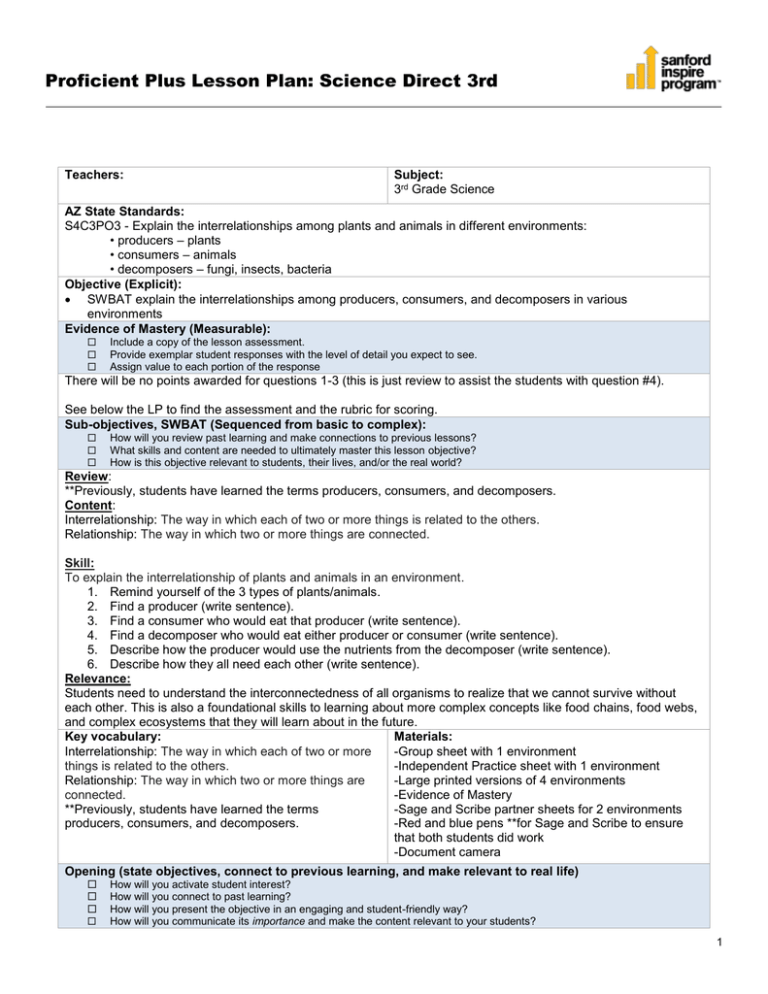
Proficient Plus Lesson Plan: Science Direct 3rd Teachers: Subject: 3rd Grade Science AZ State Standards: S4C3PO3 - Explain the interrelationships among plants and animals in different environments: • producers – plants • consumers – animals • decomposers – fungi, insects, bacteria Objective (Explicit): SWBAT explain the interrelationships among producers, consumers, and decomposers in various environments Evidence of Mastery (Measurable): Include a copy of the lesson assessment. Provide exemplar student responses with the level of detail you expect to see. Assign value to each portion of the response There will be no points awarded for questions 1-3 (this is just review to assist the students with question #4). See below the LP to find the assessment and the rubric for scoring. Sub-objectives, SWBAT (Sequenced from basic to complex): How will you review past learning and make connections to previous lessons? What skills and content are needed to ultimately master this lesson objective? How is this objective relevant to students, their lives, and/or the real world? Review: **Previously, students have learned the terms producers, consumers, and decomposers. Content: Interrelationship: The way in which each of two or more things is related to the others. Relationship: The way in which two or more things are connected. Skill: To explain the interrelationship of plants and animals in an environment. 1. Remind yourself of the 3 types of plants/animals. 2. Find a producer (write sentence). 3. Find a consumer who would eat that producer (write sentence). 4. Find a decomposer who would eat either producer or consumer (write sentence). 5. Describe how the producer would use the nutrients from the decomposer (write sentence). 6. Describe how they all need each other (write sentence). Relevance: Students need to understand the interconnectedness of all organisms to realize that we cannot survive without each other. This is also a foundational skills to learning about more complex concepts like food chains, food webs, and complex ecosystems that they will learn about in the future. Key vocabulary: Materials: Interrelationship: The way in which each of two or more -Group sheet with 1 environment things is related to the others. -Independent Practice sheet with 1 environment Relationship: The way in which two or more things are -Large printed versions of 4 environments connected. -Evidence of Mastery **Previously, students have learned the terms -Sage and Scribe partner sheets for 2 environments producers, consumers, and decomposers. -Red and blue pens **for Sage and Scribe to ensure that both students did work -Document camera Opening (state objectives, connect to previous learning, and make relevant to real life) How will you activate student interest? How will you connect to past learning? How will you present the objective in an engaging and student-friendly way? How will you communicate its importance and make the content relevant to your students? 1 -Who can raise their hand and share with us what we learned about yesterday? Yes, we learned about producers, consumers, and decomposers! To get us started we’re going to do a Shuffle, Shuffle Think Pair Share today. Teacher has posted 5 large prints of different biomes/environments. -When I say the magic word (truffle truffle), I would like for you to go to one of the large posters and SILENTLY put your finger on a producer. (truffle truffle) -Ok, Think “What is a producer?” Pair up with someone nearby and now share for 20 seconds. Now give them a high-5 and say,” Way’ta go Planeteer!” -Now when I say the magic word (truffle truffle), I would like for you to go to a DIFFERENT posters and SILENTLY put your finger on a consumer. (truffle truffle) -Ok, Think “What is a consumer?” Pair up with someone nearby and now share for 20 seconds. Now give them a high-5 and say,” You’re better than a bowl of ice cream!” Last shuffle shuffle, are you ready? -When I say the magic word (truffle truffle), I would like for you to go to AN EVEN DIFFERENT posters and SILENTLY put your finger on a decomposer. (truffle truffle) -Ok, Think “What is a decomposer?” Pair up with someone nearby and now share for 20 seconds. Now everyone give your brains a kiss and say, “Work hard, get smart!” You have 1.5 minutes to calmly find your way back your seats. As you go back to the seat, I want you to gallery walk past the 4 environments I have posted up in the room. Students preview environments that will be used later in the lesson. Did anybody notice anything special about the environments? These were the top 4 environments that everyone voted on during our math lesson yesterday! I’m excited that today we get to learn a little bit more about the environments you guys are interested in the MOST! I’m ALSO glad that we remembered all that important information about producers, consumers, and decomposers because today we are going to explain how they are all connected to each other. And if we didn’t remember what they were, we wouldn’t be able to master today’s objective. Let’s look on the board and choral read the objective. Students will choral read. **Relevance will be covered in the closing. I would love to show you guys what skill we’re learning today! Let’s go ahead and gather on the carpet. When I say the Magic Carpet word (Aladdin), I’d like for you to get ready to syllable walk to the carpet. Teacher will say these words for syllabication for students: biome, environment, and decomposer. Teacher Will: Instructional Input How will you model/explain/demonstrate all knowledge/skills required of the objective? What types of visuals will you use? How will you address misunderstandings or common student errors? How will you check for understanding? How will you explain and model behavioral expectations? Is there enough detail in this section so that another person could teach it? Since we’re going to be explaining the INTERRELATIONSHIP of plants and animals, let’s make sure we know what that means. Who remembers what the word part inter- means? Between is absolutely correct. Interrelationships are the relationships or connections between 2 or more things. So in all of our explanations today, I want for us to be explaining HOW producers, consumers, and decomposers are connected or related to each other. Our 3rd grade team of teachers have come Student Will: What will students be doing to actively capture and process the new material? How will students be engaged? Students will come and participate in the instructional input at the carpet. -Call on various students for responses through popsicle or using the color wheel (students are sitting in rows based on colors). -Students may be called up to the cork board or white board to write, point, spin, etc. Teacher tries to incorporate a minimum of 2 students for each step. 2 up with a really easy, and helpful way for you guys to do that! Teacher will post image of grassland environment on mini corkboard. Teacher will also post on the mini-corkboard the steps to explaining the interrelationships. They will then proceed with the following think aloud eliciting some student responses. First I’m going to look at the first step. Who can read that aloud? Thank you. So what are the 3 types again? Great. Can I go on to the next step? Good, let me check that off. Next I see #2…Find a producer. Teacher will do think aloud finding the producer. Can I have help writing a sentence saying that. ….Thank you! Next I see #3…Find a consumer who would eat that producer. Can someone point out on the poster a consumer who would eat that producer? Thank you. Now I’m going to put that into a sentence. _________is a consumer who eats _________. Am I done with 3? Let’s check it off. Next I see #4 Find a decomposer who would eat either the producer or consumer. Teacher does think aloud for how to find that decomposer. Can someone help me put that into a sentence? Thank you. That is a great sentence! Let’s check off #4. Wow, we’re already to #5…is this easy? Awesome! Describe how the producer would use the nutrients from the decomposer. Oh, I know how to write that in a sentence. ________as a producer uses nutrients in the soil left behind by decomposers to grow and make food. Can I check off #5? Wow, we’re on the last sentence. #6 Describe how they all need each other. Turn to a carpet partner and share how these plants and animals need each other. Teacher will listen to student-to-student responses and call on a great answer to share out. ______can you share you response? Perfect and that is my last sentence. Who is the Star of the Week? Star_____ can you choose 1 person to read our explanation? Class Snaps and a rollercoaster for such a wonderful reading. Class that is all that we’re doing today! Raise your hand if you’re ready to do this with your group? Ok, when I say the magic leave the carpet word (genie and the lamp), you can Syllable walk to your seats for the next set of directions. Teacher will say these words: consumer, producer, energy. 3 Co-Teaching Strategy Which co-teaching approach will you use to maximize student achievement? One teach and one observe. Differentiation Strategy What accommodations/modifications will you include for specific students? Do you anticipate any students who will need an additional challenge? Students B, F, and K have visual impairments and therefore have their carpet seats at the front of their rows. Students L, M and N are students who can easily put their thoughts into sentences. I will call on them often throughout this section to assist in quickly coming up with sentences. Students I and J are on behavior plans to assist in their on-task time and more positive behaviors. I have both of them near the front but separated by the class and on the edges. I will also call on them often throughout carpet time (for answers, to point at things on the board, cross of steps, etc.) to keep them actively engaged. Teacher Will: How will you ensure that all students have multiple opportunities to practice new content and skills? What types of questions can you ask students as you are observing them practice? How/when will you check for understanding? How will you provide guidance to all students as they practice? How will you explain and model behavioral expectations? Is there enough detail in this section so that another person could facilitate this practice? Ok, in our groups we are going to follow the exact same steps that we just did all together. Guided Practice One’s you will be in charge making sure the group is following our steps for explanation and use of scientific vocabulary. Two’s you will be making sure that everyone in the group is following along and understands the material. Student Will: How will students practice all knowledge/skills required of the objective, with your support, such that they continue to internalize the sub-objectives? How will students be engaged? How will you elicit student-to-student interaction? How are students practicing in ways that align to independent practice? Students will craft an explanation paragraph for the desert environment as groups with the described responsibilities. Students will craft and explanation paragraph for the pond and tundra in sage and scribe Sage tells scribe exactly what to write, scribe writes it. Then they switch roles. Three’s you will be the group’s official scribe authenticator- after gathering everyone’s ideas, you’re the person who officially puts it correctly into a sentence that everyone can follow. Four’s you are to make sure that everyone is doing their work and will finish by the time the timer goes off. Each of you will have a wkst that has a picture of our next environment, desert environment, and space for you to write your explanation. Everyone take 3 seconds and point to where in the room you can find our steps? Great…you have 10 minutes. Remember, if we have complete on task behavior for the first 3 minutes, we get science music in the background. 4 Teacher moves around the room to monitor progress towards the objective and on task behavior. Science music is a CD compiled of music that is related to whatever unit of study. Students LOVE have the fun songs on in the background when they work and helps all students to be motivated to be on-task. Reconvene students back to whole group setting. Have posted the desert environment and call on various students to identify producers, consumers, and decomposers. For doc camera, call on 3 students to come up and read their work. Lead class snaps (way of applauding) for each student and have 1 other student share a compliment. Great, you and your groups did an excellent job! We’re now going to take 15 minutes do some more practice doing sage and scribe. This is the most popular cooperative learning structure. You are going to now receive 1 more wkst that has a front and back: you will be the sage for one side, and scribe for the other. There are 2 environments on the wkst (pond and tundra) and space for you to write your explanations. Evens you will be partners and odds you will be partners. Everyone take 3 seconds and point to where in the room you can find our steps? Great…you have 10 minutes. Remember, if we have complete on-task behavior for the first 3 minutes, we get science music in the background. Teacher moves around the room to monitor progress towards the objective and on task behavior. Science music is a CD compiled of music that is related to whatever unit of study. Students LOVE have the fun songs on in the background when they work and helps all students to be motivated to be on-task. Co-Teaching Strategy Which co-teaching approach will you use to maximize student achievement? One Teach and One Observe Differentiation Strategy What accommodations/modifications will you include for specific students? Do you anticipate any students who will need an additional challenge? How can you utilize grouping strategies? Students A, B, C have particular goals when it comes to writing complete sentences. I also know that Students D and E also struggle with writing complete sentences. I have created a form of all the worksheets that offers sentences frames for the students to use. During guided practice only these students have these sentence frames. Their partners and group members know that they can use those sentence frames if they want to, but are to make sure that A, B and C are using them correctly with the partner/group sentences. 5 Student F, G, and H are students that for most all writing activities must first verbally process the information they want to say before they write it. They have been set up with a partner and the expectations that it is ok to explain their ideas first and then write them down. During this part of the lesson since it is guided practice, they can also receive coaching and feedback from their partners. Students I and J are both on behavior plans for increasing the amount of time they are on task and doing positive behaviors. It is essential that I monitor their work and actions heavily for the first 10 minutes to start this part of the lesson. I have instructed their partners to be sages first which forces them to scribes, where they have a task ready for them to complete. Teacher Will: Student Will: How will you plan to coach and correct during this practice? How will you provide opportunities for remediation and extension? How will you clearly state and model academic and behavioral expectations? Did you provide enough detail so that another person could facilitate the practice? Independent Practice -We are now going to practice with another environment, but this time we’ll do it by ourselves. We’ve now practiced the skill 3 times together but I want to see how well you can do this all by yourself. -You will receive 1 piece of paper that has a picture of the environment on it and a space where you can write your explanation. -We are going to work on this for 10 minutes, if you get finished early…everyone point to the list of things you can do (list is at the corner of activities for early finishers). -When you are done, check that it has your name, it’s complete and put it on the back U table. Co-Teaching Strategy How will students independently practice the knowledge and skills required by the objective? How will students be engaged? How are students practicing in ways that align to assessment? How are students using self-assessment to guide their own learning? How are you supporting students giving feedback to one another? -Students will be working independently on the Amazon Rain Forest Environment. Which co-teaching approach will you use to maximize student achievement? One Teach, One Observe Differentiation Strategy What accommodations/modifications will you include for specific students? Do you anticipate any students who will need an additional challenge? Students A, B, and C have particular goals when it comes to writing complete sentences. I also know that Students D and E also struggle with writing complete sentences. I have created a form of all the worksheets that offers sentences frames for the students to use. Student F, G, and H are students that for most all writing activities must first verbally process the information they want to say before they write it. They have been set up with a partner and the expectation that it is ok to explain their ideas first and then write them down. At this point in the lesson, their partners aren’t allowed to coach or give feedback but just listen (as this is the Independent practice of the LP). Students I and J are both on behavior plans for increasing the amount of time they are on task and doing positive behaviors. It is essential that I monitor their work and actions heavily for the first 10 minutes to start this part of the lesson off in a positive direction and because they particularly struggle with working and being focused independently. Closing/Student Reflection/Real-life connections: How will students summarize and state the significance of what they learned? Why will students be engaged? -Teacher will use popsicle sticks to call on students -What did we learn how to do today? Who can explain in GENERAL how producers, consumers, and decomposers are interrelated? -Why is it important that we learn about these things? Teacher transitions to Evidence of Mastery 6 Evidence of Mastery Name:______________________ Use the above picture to answer questions 1-3. 1. Draw a circle around 2 producers. 2. Draw a rectangle around 2 consumers. 3. Draw a star next to a decomposer. 7 Use the picture to answer question 4. 4. Explain the interrelationships between the plants and animals in the picture. Make sure you use appropriate scientific vocabulary and complete sentences. The grass is a producer. The deer is a consumer who eats the grass. When the deer dies, the mushrooms and worms, which are decomposers, will eat the deer to make nutrients. The grass will use those nutrients to help make more food. They all need each other to survive. If something were to happen to one of them, they all would be affected. 8 The Following are the different resources to be used. 9 Group Wkst Name:___________________ Date:_____ Explain the interrelationships between producers, consumers, and decomposers. __________________________________________________________________________________________ __________________________________________________________________________________________ __________________________________________________________________________________________ __________________________________________________________________________________________ 10 __________________________________________________________________________________________ ______________________________ Sage and Scribe Wkst (pg 1) Sage:___________________ Scribe:___________________ Date:_____ Explain the interrelationships between producers, consumers, and decomposers. __________________________________________________________________________________________ __________________________________________________________________________________________ __________________________________________________________________________________________ __________________________________________________________________________________________ 11 __________________________________________________________________________________________ ______________________________ Sage and Scribe Wkst (pg 2) Sage:___________________ Scribe:___________________ Date:_____ Explain the interrelationships between producers, consumers, and decomposers. 12 __________________________________________________________________________________________ __________________________________________________________________________________________ __________________________________________________________________________________________ __________________________________________________________________________________________ __________________________________________________________________________________________ ______________________________ Independent Practice Name:___________________ Date:_____ 13 Explain the interrelationships between producers, consumers, and decomposers. __________________________________________________________________________________________ __________________________________________________________________________________________ __________________________________________________________________________________________ __________________________________________________________________________________________ __________________________________________________________________________________________ ______________________________ 14
